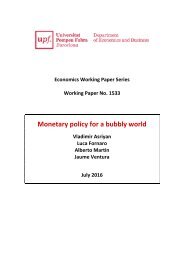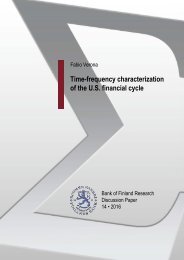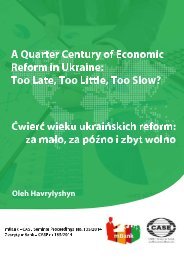Necessity as the mother of invention monetary policy after the crisis
n?u=RePEc:dnb:dnbwpp:525&r=mac
n?u=RePEc:dnb:dnbwpp:525&r=mac
You also want an ePaper? Increase the reach of your titles
YUMPU automatically turns print PDFs into web optimized ePapers that Google loves.
Second, a low rate <strong>of</strong> inflation provides some insurance against deflation, which is<br />
generally regarded <strong>as</strong> a more serious problem than inflation. Deflation raises <strong>the</strong> real cost<br />
<strong>of</strong> servicing debt, perhaps forcing debtors to sell <strong>as</strong>sets or default on <strong>the</strong>ir loans. It can<br />
<strong>the</strong>refore create a vicious cycle <strong>of</strong> rising real debt burdens and financial distress, which in<br />
turn may cause more downward pressure on prices.<br />
Third, <strong>the</strong>re are upward bi<strong>as</strong>es in most <strong>of</strong>ficial estimates <strong>of</strong> inflation. Mis-me<strong>as</strong>urement<br />
may result from, e.g., inadequate adjustments for quality improvement, difficulties in<br />
incorporating new goods into <strong>the</strong> indexes, changes in consumers’ shopping patterns that<br />
may favor discount retailers, and <strong>the</strong> cl<strong>as</strong>sic substitution bi<strong>as</strong> (Billi and Kahn, 2008).<br />
Finally, at very low levels <strong>of</strong> inflation, nominal interest rates will also be very low,<br />
limiting a central bank’s ability to e<strong>as</strong>e <strong>monetary</strong> <strong>policy</strong> in response to economic<br />
weakness. Once <strong>the</strong> <strong>policy</strong> rate reaches <strong>the</strong> lower bound, which may be below zero,<br />
conventional <strong>monetary</strong> e<strong>as</strong>ing becomes impossible.<br />
This l<strong>as</strong>t point is <strong>the</strong> focus <strong>of</strong> <strong>the</strong> current discussion. Before <strong>the</strong> financial <strong>crisis</strong>, it w<strong>as</strong><br />
widely believed that 2 per cent inflation w<strong>as</strong> sufficient to minimize <strong>the</strong> probability that <strong>the</strong><br />
lower bound would be a constraint and that, if it occurred, <strong>the</strong> likely damage would be<br />
small. The <strong>after</strong>math <strong>of</strong> <strong>the</strong> <strong>crisis</strong> h<strong>as</strong> changed those views. Whe<strong>the</strong>r central banks should<br />
raise <strong>the</strong>ir inflation targets to account for <strong>the</strong> risk <strong>of</strong> hitting <strong>the</strong> lower bound hinges on 1)<br />
how serious this risk is; 2) how high <strong>the</strong> lower bound is; 3) <strong>the</strong> welfare costs <strong>of</strong> hitting <strong>the</strong><br />
bound; and 4) <strong>the</strong> costs (including loss <strong>of</strong> credibility) <strong>of</strong> transitioning to a higher inflation<br />
target. Fur<strong>the</strong>rmore, it is important to distinguish between two different concerns:<br />
avoiding <strong>the</strong> effective lower bound in <strong>the</strong> first place, and boosting <strong>the</strong> economy once <strong>the</strong><br />
bound is binding. We take <strong>the</strong>se up in turn.<br />
Several papers quantify <strong>the</strong> risks <strong>of</strong> hitting <strong>the</strong> lower bound by simulating New<br />
Keynesian models <strong>of</strong> <strong>the</strong> economy. Generally, <strong>the</strong>y find that <strong>the</strong> problem is not serious<br />
enough to justify a higher rate <strong>of</strong> inflation. (One well-known example is Reifschneider<br />
and Williams, 2000.) One re<strong>as</strong>on is that <strong>the</strong> welfare costs <strong>of</strong> such episodes are low<br />
(Coibion et al., 2012). But proponents <strong>of</strong> raising <strong>the</strong> inflation target argue that <strong>the</strong> risks<br />
are greater than <strong>the</strong>se models suggest—because, for example, inflation and both nominal<br />
and real interest rates were much higher in <strong>the</strong> simulation periods than <strong>the</strong>y are likely to<br />
be going forward (Ball, 2014; Krugman, 2014). So smaller shocks will suffice to push <strong>the</strong><br />
<strong>policy</strong> rate to its lower bound.<br />
Despite its <strong>the</strong>oretical importance to this and o<strong>the</strong>r issues, recent empirical studies have<br />
not come up with a uniform empirical definition <strong>of</strong> <strong>the</strong> natural rate <strong>of</strong> interest. Well-known<br />
estimates by Laubach and Williams (2015) suggest that <strong>the</strong> natural rate in <strong>the</strong> U.S.<br />
fluctuates over time but exhibits a downward trend, reaching about 2 per cent in 2007 and<br />
plummeting to zero (where it remains) by 2010. Hamilton et al. (2015), however,<br />
emph<strong>as</strong>ize <strong>the</strong> large uncertainty around such estimates.<br />
When Blanchard et al. (2010) proposed to raise <strong>the</strong> inflation target, <strong>the</strong> lower bound w<strong>as</strong><br />
thought to be no lower than zero. Now, we think it is negative, which leaves central<br />
bankers more room to operate. Fur<strong>the</strong>rmore, <strong>the</strong> <strong>crisis</strong> h<strong>as</strong> shown that <strong>the</strong> central bank still<br />
h<strong>as</strong> viable tools once <strong>the</strong> lower bound on nominal interest rates is hit—including forward<br />
guidance, large-scale purch<strong>as</strong>es <strong>of</strong> securities, and exchange rate interventions. If such<br />
9








